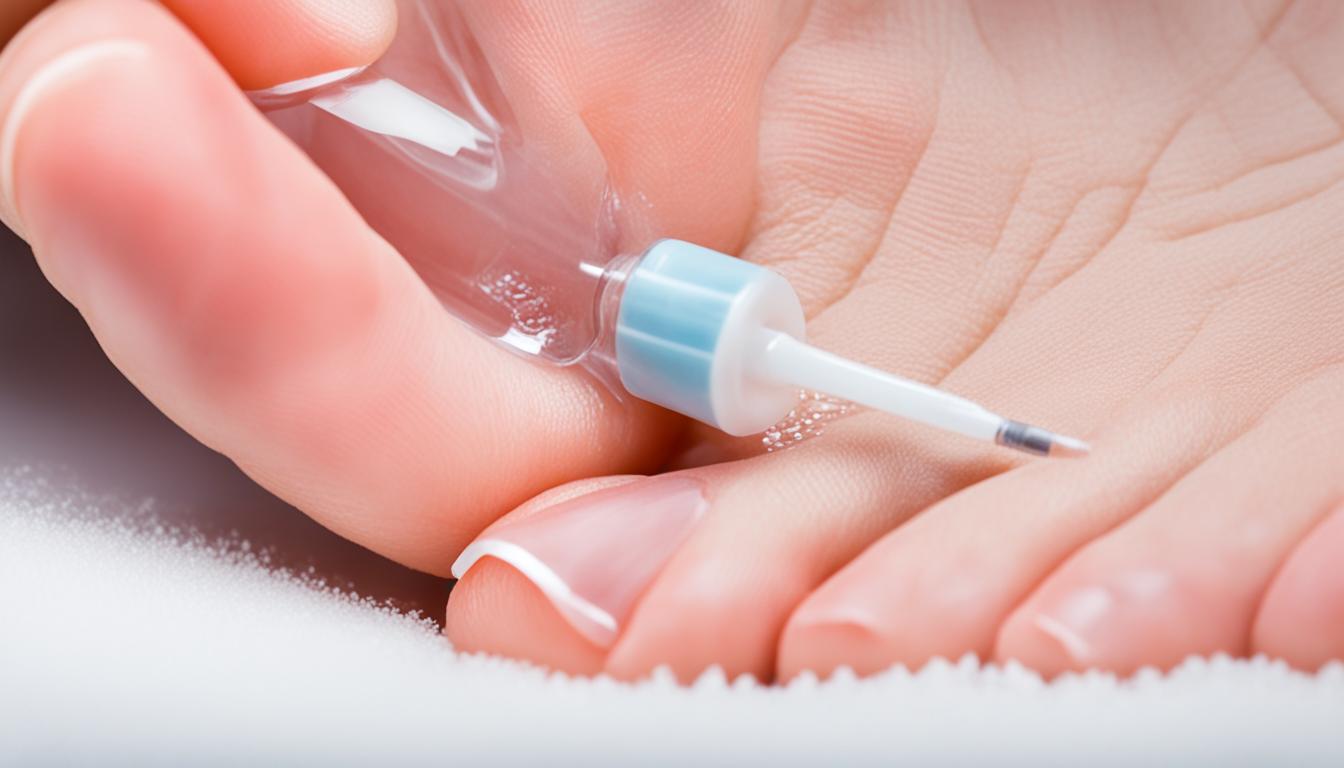Did you know that approximately 20% of people are at risk of experiencing an ingrown nail at some point in their lives? Ingrown nails can be quite painful and may lead to infections if left untreated. Fortunately, there are effective treatments available to alleviate the pain and promote healthy nail growth.
In this article, we will explore various treatment options for in-grown nails, including both professional and home remedies. Whether you’re dealing with a mild case or a more severe condition, we’ve got you covered with practical advice and helpful information.
Key Takeaways:
- Approximately 20% of the population will experience an in-grown nail in their lifetime.
- In-grown nails can cause discomfort and potentially lead to infections.
- Effective treatment solutions exist to alleviate discomfort and promote healthy nail growth.
- This article provides information on various treatment options for in-grown nails.
- Both professional treatments and home remedies will be discussed.
Diagnosis of In-Grown Nails
A healthcare provider plays a crucial role in the diagnosis of in-grown nails. By carefully evaluating the symptoms and conducting a thorough physical examination of the affected nail and surrounding skin, they can accurately assess the severity of the condition and guide the appropriate treatment plan.
When it comes to in-grown nails diagnosis, healthcare providers rely on their expertise to identify key indicators that confirm the presence of this condition. They look for common symptoms such as pain, redness, swelling, and infection in the affected area. Additionally, they examine the nail and surrounding skin to determine the extent of the ingrowth and assess any signs of inflammation or tissue damage.
During the physical examination, healthcare providers may gently manipulate the affected nail to assess its mobility and sensitivity. They may also apply pressure to different areas surrounding the nail to identify points of tenderness or discomfort.
“The expertise of a healthcare provider is invaluable in diagnosing in-grown nails. By thoroughly examining the symptoms and performing a physical examination, they can provide an accurate diagnosis and tailor an effective treatment plan.”
The thoroughness of the diagnosis is crucial for determining the most appropriate treatment approach for in-grown nails. It allows healthcare providers to effectively address the patient’s specific needs, whether opting for conservative measures or more advanced interventions.
To illustrate the diagnostic process for in-grown nails, the table below outlines the common symptoms and findings that help healthcare providers identify this condition:
| Symptoms | Pain, redness, and swelling in the affected area |
|---|---|
| Physical Examination Findings | Signs of ingrowth, inflammation, or infection; tenderness upon manipulation; limited mobility of the affected nail |
By considering all the diagnostic information gathered, healthcare providers can effectively diagnose in-grown nails, ensuring appropriate treatment interventions and improved patient outcomes.
Treatment Options for In-Grown Nails
When it comes to treating in-grown nails, there are various options available to alleviate discomfort and promote healing. The choice of treatment depends on the severity of the condition. Here are some common treatment options:
- Lifting the Nail: One approach involves lifting the nail edge and placing cotton, dental floss, or a splint underneath to separate it from the skin. This helps relieve pressure and allows the nail to grow properly.
- Taping the Nail: Another method is to tape the nail using specialized medical tape. This technique helps in repositioning the nail and reducing pain and inflammation.
- Gutter Splint: In more severe cases, a gutter splint may be applied under the nail. This splint acts as a support and helps ease pain and discomfort.
- Partial Nail Removal: When conservative treatments fail to provide relief, partial nail removal might be necessary. This procedure involves removing a portion of the nail that is causing the problem, while leaving the healthy part intact.
- Nail and Tissue Removal: In the most severe cases, complete nail and underlying tissue removal may be required. This helps prevent recurrent in-grown nails by eliminating the source of the problem.
It’s important to note that these treatments should be performed by a qualified healthcare professional. They have the expertise and tools to ensure safe and effective outcomes. Seeking professional treatment is particularly crucial when dealing with recurring or complicated cases of in-grown nails.
Comparison of In-Grown Nail Treatment Options
| Treatment Option | Description | Benefits |
|---|---|---|
| Lifting the Nail | Placing cotton, dental floss, or a splint under the nail edge | – Relieves pressure and discomfort – Promotes proper nail growth |
| Taping the Nail | Using specialized medical tape to reposition the nail | – Reduces pain and inflammation – Improves nail alignment |
| Gutter Splint | Application of a splint under the nail | – Provides support and pain relief – Prevents further damage |
| Partial Nail Removal | Removal of the portion of the nail causing the problem | – Resolves persistent in-grown nail issues – Preserves the healthy part of the nail |
| Nail and Tissue Removal | Complete removal of the nail and underlying tissue | – Prevents recurrent in-grown nails – Addresses severe or chronic cases |
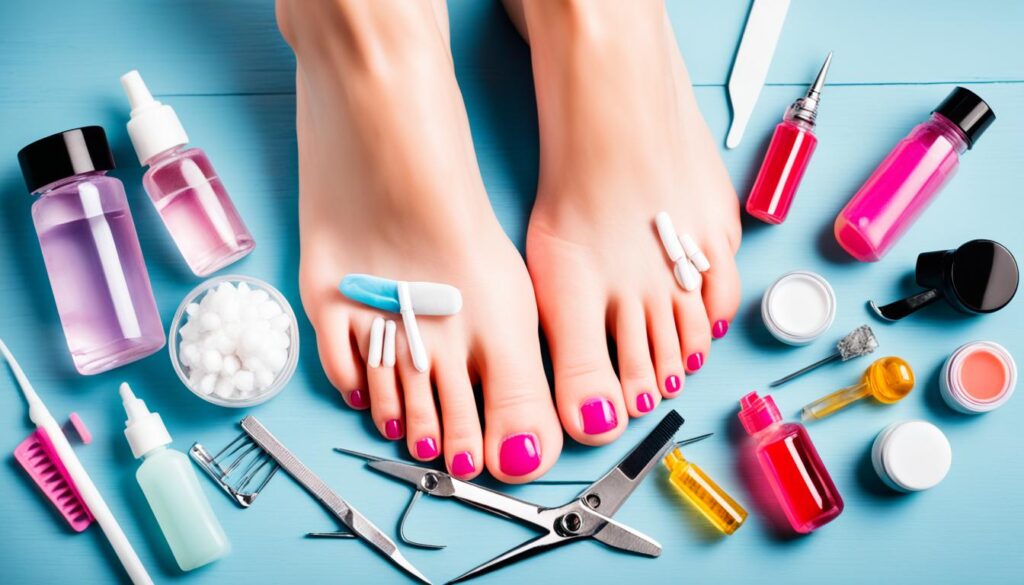
With the right treatment approach, individuals with in-grown nails can experience relief from pain and discomfort. However, it’s essential to consult a healthcare professional for proper diagnosis and treatment recommendations tailored to individual needs.
Home Remedies for In-Grown Nails
When dealing with in-grown nails, there are several effective home remedies that can alleviate discomfort and promote healing. By incorporating these remedies into your routine, you can find relief and improve the condition of your nails.
Soaking the Foot
One of the most soothing remedies for in-grown nails is soaking the affected foot in warm, soapy water. This helps soften the skin and reduces inflammation, making it easier to address the nail issue.
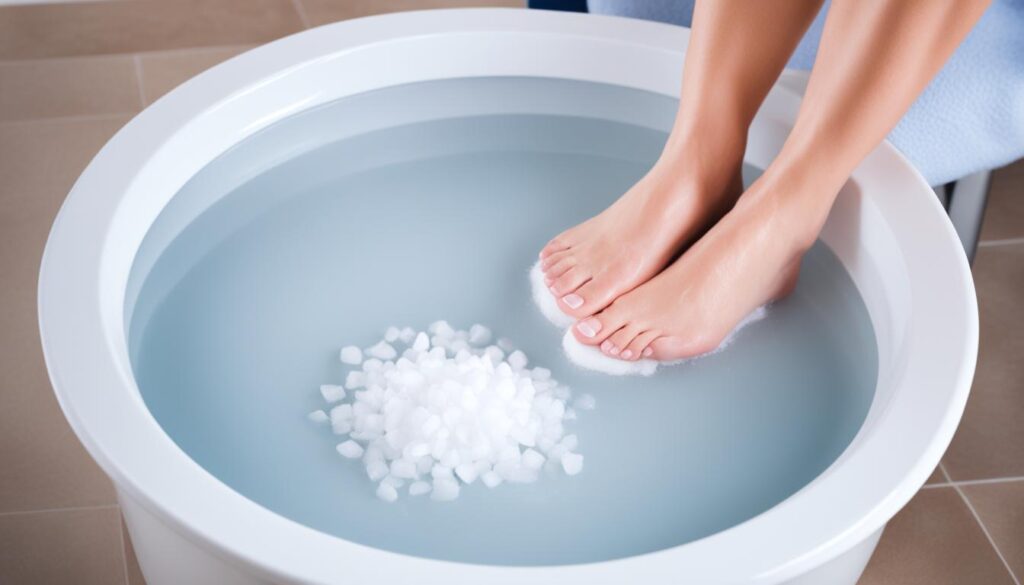
Cotton or Dental Floss
Placing cotton or dental floss under the edge of the in-grown nail can help lift it away from the skin. This separation relieves pressure and allows the nail to grow properly. Remember, use clean and sterile materials when performing this remedy.
Petroleum Jelly
Applying petroleum jelly to the affected area can provide lubrication and reduce friction, minimizing discomfort caused by in-grown nails. Gently massage the jelly around the nail to moisturize and soothe the skin.
Proper Footwear
Choosing comfortable and properly fitting footwear is essential for preventing and treating in-grown nails. Opt for shoes with enough room in the toe box to allow your nails to grow naturally. Avoid tight-fitting or narrow shoes that can put pressure on the toes. Additionally, look for footwear with breathable materials to promote good foot hygiene.
By implementing these simple yet effective home remedies, you can take control of your in-grown nails and support the healing process. Remember, if you don’t see improvement or if the condition worsens, it’s important to consult a healthcare professional for further evaluation and treatment options.
In-Grown Nail Treatment Precautions
When it comes to treating in-grown nails, it’s essential to take certain precautions to ensure the best possible outcome. While home remedies can be effective in many cases, seeking medical attention is important if these remedies don’t provide relief or if there is an infection. Additionally, if you experience recurring problems on the same toe, it may be necessary to explore more intensive treatment options, such as partial nail removal or removal of the nail and underlying tissue.
Seeking medical attention for in-grown nails is crucial because healthcare professionals have the expertise to diagnose the severity of the condition and recommend appropriate treatments. They can identify any underlying factors contributing to the in-grown nails and provide guidance on the most suitable course of action.
In certain cases, recurring problems may indicate an underlying issue that requires medical intervention. By addressing the root cause of the in-grown nails, healthcare providers can implement more advanced treatments to prevent the problem from persisting.
Remember, it’s important to prioritize your foot health and seek professional care when necessary. By doing so, you can find long-term relief from in-grown nails and prevent further complications from arising.
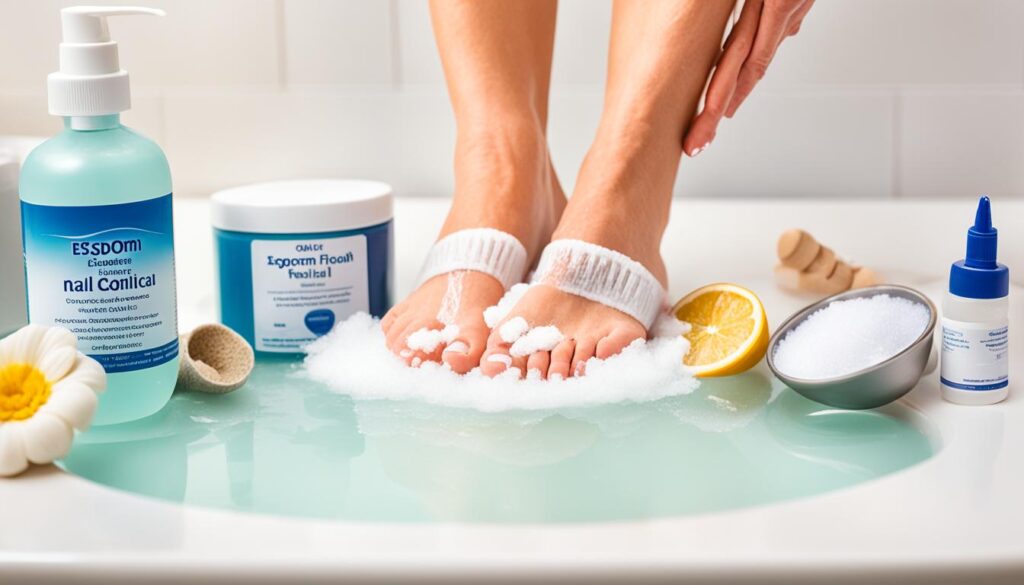
When faced with in-grown nails, be proactive and seek medical attention if needed. Don’t let recurring problems on the same toe cause unnecessary discomfort. With the right precautions and timely treatment, you can overcome the challenges of in-grown nails and regain your comfort and well-being.
Self-Care for In-Grown Nails
When it comes to managing in-grown nails, self-care plays a crucial role in alleviating pain and promoting healing. Here are some effective self-care techniques that can make a difference:
- Soak your feet: Start by soaking your feet in warm, soapy water for about 15-20 minutes. This helps soften the skin and nails, making it easier to manage the in-grown nail.
- Place cotton or dental floss: Gently lift the edge of the in-grown nail and place a small piece of cotton or dental floss underneath. This helps separate the nail from the surrounding skin and encourages proper growth.
- Wear proper footwear: Opt for shoes that provide ample room for your toes, avoiding tight or narrow footwear that puts pressure on the in-grown nail. This allows for better airflow and reduces friction.
- Take pain relievers: Over-the-counter pain relievers such as acetaminophen or ibuprofen can help manage any discomfort associated with the in-grown nail. Always follow the recommended dosage.
By incorporating these self-care practices into your routine, you can proactively address in-grown nails and find relief. Remember, self-care is just one aspect of managing in-grown nails. It’s important to seek medical attention if your symptoms worsen or if you notice signs of infection.

When to Seek Medical Attention for In-Grown Nails
If you’re experiencing severe pain, signs of infection such as redness, swelling, or pus, or if you have underlying conditions like diabetes or poor circulation, it’s important to see a healthcare provider for in-grown nails. Seeking medical attention ensures that you receive appropriate treatment and helps prevent complications.
Severe pain can be an indication of a more advanced or complicated in-grown nail, and it may require a professional intervention to alleviate the discomfort and resolve the underlying issue. Infections can occur when the in-grown nail causes a break in the skin, creating an entry point for bacteria. Prompt medical attention is essential to prevent the infection from spreading and causing further complications.
Individuals with underlying conditions such as diabetes or poor circulation may have compromised healing abilities, making it crucial to involve a healthcare provider in the treatment process. These conditions can increase the risk of complications and hinder proper healing. By consulting with a doctor, you can ensure that the treatment plan takes into account any specific considerations related to your health.
Remember, in-grown nails should not be ignored, especially if you are experiencing severe pain, signs of infection, or have underlying health conditions. Seeking medical attention for in-grown nails can help alleviate discomfort, prevent complications, and promote effective healing.
| When to See a Doctor for In-Grown Nails |
|---|
| Severe pain |
| Signs of infection (redness, swelling, pus) |
| Underlying conditions (diabetes, poor circulation) |
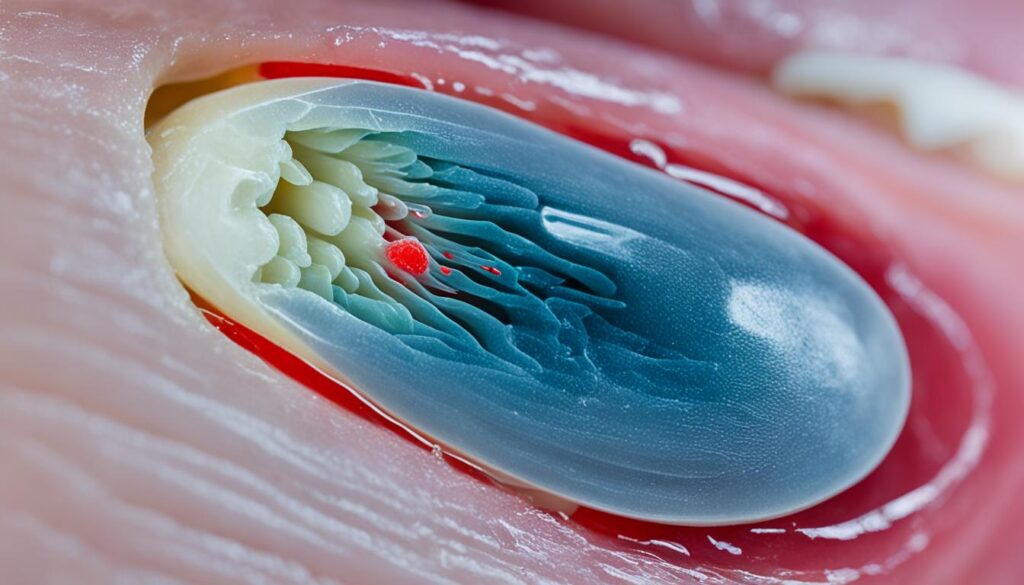
Prevention of In-Grown Nails
Preventing in-grown nails is essential for maintaining the health and comfort of your feet. By following simple practices and incorporating good foot care habits into your routine, you can minimize the risk of developing in-grown nails.
Proper Nail Trimming
One of the key measures in preventing in-grown nails is to trim your nails properly. Use clean and sharp nail clippers or scissors to cut your nails straight across, avoiding rounded or short cuts. Be sure to leave a small white edge visible after trimming. This helps prevent the nail from growing into the surrounding skin, reducing the likelihood of an in-grown nail.
Avoiding Tight Shoes
Wearing properly fitting shoes is crucial for preventing in-grown nails. Avoid shoes that squeeze or cramp your toes, as these can put unnecessary pressure on your nails and increase the risk of them growing into the skin. Opt for shoes with a roomy toe box that allows your toes to move freely. This helps prevent nail compression and ensures proper nail growth.
Good Foot Hygiene
Maintaining good foot hygiene is another important aspect of in-grown nail prevention. Clean your feet regularly with mild soap and warm water, paying special attention to the area around your nails. Gently dry your feet, including the spaces between your toes, to prevent moisture buildup, which can contribute to in-grown nails. Additionally, moisturize your feet with a hydrating lotion to keep the skin supple and reduce the risk of dryness and cracking.
By implementing these preventive measures, you can significantly reduce the likelihood of developing in-grown nails. Proper nail trimming, avoiding tight shoes, and maintaining good foot hygiene are simple yet effective strategies that promote overall foot health and minimize the discomfort associated with in-grown nails.
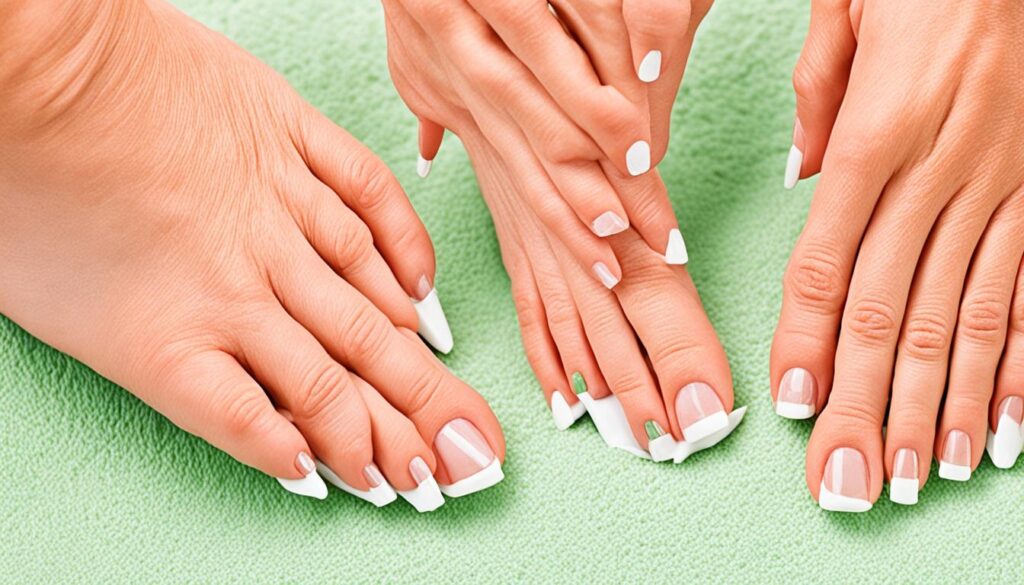
Conservative Therapy for In-Grown Nails
When it comes to the treatment of in-grown nails, conservative therapy offers effective options that can alleviate discomfort and promote healing. These non-invasive approaches are often the first line of treatment and can be easily done at home.
Soaking the Foot
Soaking the affected foot in warm, soapy water is a simple and soothing method that can help reduce inflammation and soften the skin around the nail. This can make it easier to gently lift the nail and prevent further ingrowth.
Topical Ointments
Applying topical ointments with antiseptic or antibacterial properties can help keep the affected area clean and prevent infection. These ointments can be easily applied to the affected nail and surrounding skin, providing an additional layer of protection.
Cotton Wisps or Dental Floss
Using cotton wisps or dental floss can help gently lift the edge of the ingrown nail, creating a barrier between the nail and the surrounding skin. This reduces the pressure and friction, allowing the nail to grow properly and preventing further discomfort.
Toe Protectors
Wearing toe protectors can provide additional support and cushioning to the affected toe, reducing the pressure on the ingrown nail. These protectors are usually made of soft materials and can be easily worn with regular footwear.
By implementing these conservative therapies, individuals can effectively manage in-grown nails and promote healthy nail growth. However, it’s important to note that if the condition worsens or if there are signs of infection, it’s advisable to seek medical attention for further evaluation and treatment.
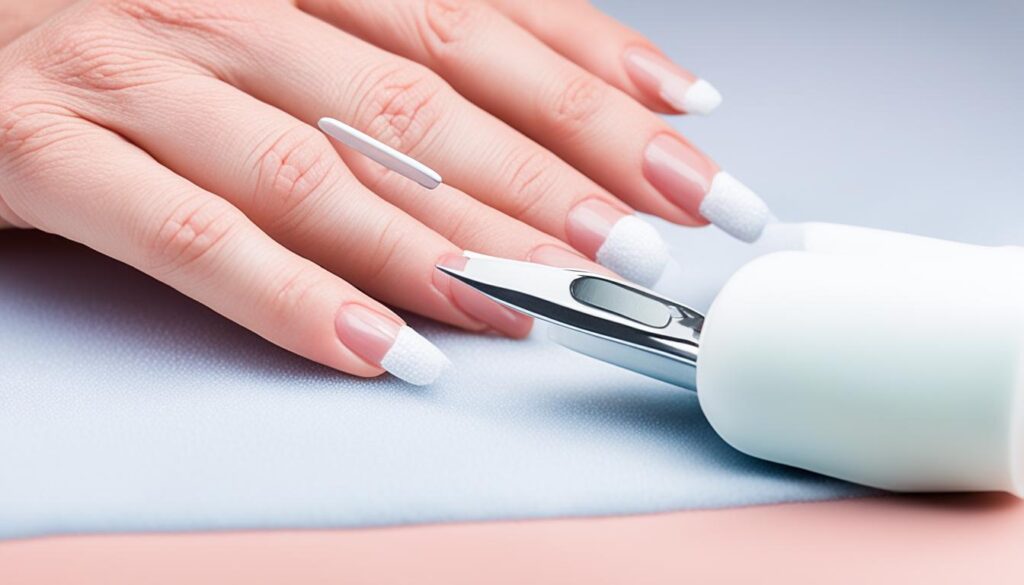
Conservative therapy for in-grown nails includes soaking the foot in warm, soapy water, applying topical ointments, using cotton wisps or dental floss under the nail, and wearing toe protectors.
Surgical Therapy for In-Grown Nails
When conservative treatments fail to provide relief for in-grown nails, surgical therapy becomes a viable option. In more severe cases, surgical interventions can offer long-term solutions for patients suffering from chronic discomfort. Let’s explore the various surgical techniques used to address in-grown nails:
Partial Nail Avulsion
Partial nail avulsion is a common surgical procedure for in-grown nails. It involves the removal of the problematic portion of the nail, targeting the area causing the pain and inflammation. A local anesthetic is typically administered before the surgery to ensure minimal discomfort during the procedure.
Once the partial nail avulsion is complete, your healthcare provider may consider the use of phenolization to prevent regrowth and future in-grown nails.
Phenolization
Phenolization refers to the application of phenol, a chemical compound, to the nail bed. This procedure is performed after partial nail avulsion and aims to destroy the nail matrix, where the nail cells responsible for growth are located. By effectively preventing regrowth, phenolization reduces the risk of recurrent in-grown nails.
Phenolization is a reliable technique that boasts a high success rate in preventing the recurrence of in-grown nails. While it may result in a more prolonged healing process, the long-term benefits make it a preferred choice for many patients.
Full Nail Removal
In rare and severe cases of chronic in-grown nails, full nail removal may be necessary. This procedure involves the complete removal of the affected nail along with the underlying tissue. Full nail removal is typically reserved for instances where other treatments have failed to provide relief or when there is a recurring problem in the same toe.
Although full nail removal may seem like an extreme solution, it can alleviate persistent discomfort and prevent future complications.
It’s important to note that surgical interventions for in-grown nails should always be performed by a qualified healthcare professional. If you’re considering surgical therapy, consult your healthcare provider to discuss the potential benefits, risks, and expected outcomes based on your specific condition.
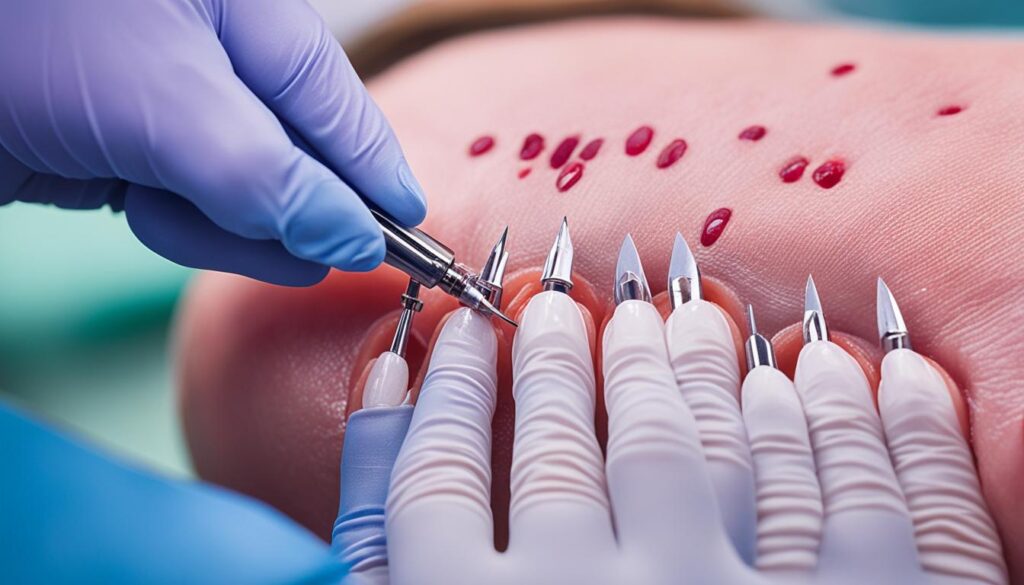
A table displaying a comparison of surgical therapies for in-grown nails:
| Surgical Therapy | Procedure | Advantages | Disadvantages |
|---|---|---|---|
| Partial Nail Avulsion | Removal of problematic portion of the nail | Targeted relief, minimal tissue disruption | Risk of regrowth |
| Phenolization | Application of phenol to destroy nail matrix | Prevents regrowth, reduces recurrence | Prolonged healing process |
| Full Nail Removal | Complete removal of affected nail and tissue | Alleviates persistent discomfort, prevents future problems | Loss of nail, longer recovery time |
Common Causes and Risk Factors of In-Grown Nails
In-grown nails can be caused by various factors, including improper nail trimming, wearing tight shoes, and poor foot hygiene. These factors can contribute to the development of in-grown nails and increase the risk of experiencing this uncomfortable condition.
Improper Nail Trimming: When nails are not cut properly, they can grow into the surrounding skin, leading to the formation of in-grown nails. Trimming nails too short or rounding the corners too much can increase the likelihood of nail penetration and subsequent discomfort.
Tight Shoes: Wearing shoes that are too tight or narrow can exert pressure on the toes, pushing the nails into the skin. This constant friction and compression can cause the nails to grow sideways or even penetrate the skin, resulting in in-grown nails.
Poor Foot Hygiene: Neglecting proper foot hygiene, such as failing to clean and dry the feet regularly, can create an environment conducive to the development of in-grown nails. Excessive moisture and dirt accumulation can soften the skin around the nails, making it easier for the nails to grow into the skin and cause discomfort.
Aside from these causes, there are also several risk factors that can make individuals more susceptible to in-grown nails. These risk factors include:
- Repetitive Trauma: Engaging in activities that involve repeated trauma to the toes, such as running or kicking, can increase the likelihood of in-grown nails.
- Genetic Predisposition: Some individuals may have a genetic predisposition to develop in-grown nails, making them more prone to experiencing this condition.
- Medical Conditions: Certain medical conditions like diabetes or obesity can affect the health of the nails and increase the risk of developing in-grown nails.
Understanding these common causes and risk factors can help individuals take necessary precautions and reduce the likelihood of facing the discomfort of in-grown nails.

Presentation and Classification of In-Grown Nails
In-grown nails can present with a range of symptoms, including pain, swelling, and infection. The severity of these symptoms and the extent of nail and skin involvement can help classify in-grown nails into mild, moderate, or severe cases.
In mild cases, the pain and discomfort may be minimal, and there may be slight redness or swelling around the affected nail. These cases can often be managed with self-care measures and home remedies.
In moderate cases, the pain and swelling may be more pronounced, and there may be increased redness and tenderness. Infection may be present, requiring medical attention and treatment to prevent complications.
Severe cases of in-grown nails exhibit intense pain, significant swelling, and severe infection. The nail may embed deeply into the surrounding skin, causing abscesses or ulcers. These cases often require prompt medical intervention, including surgical treatment options, to alleviate symptoms and prevent further complications.
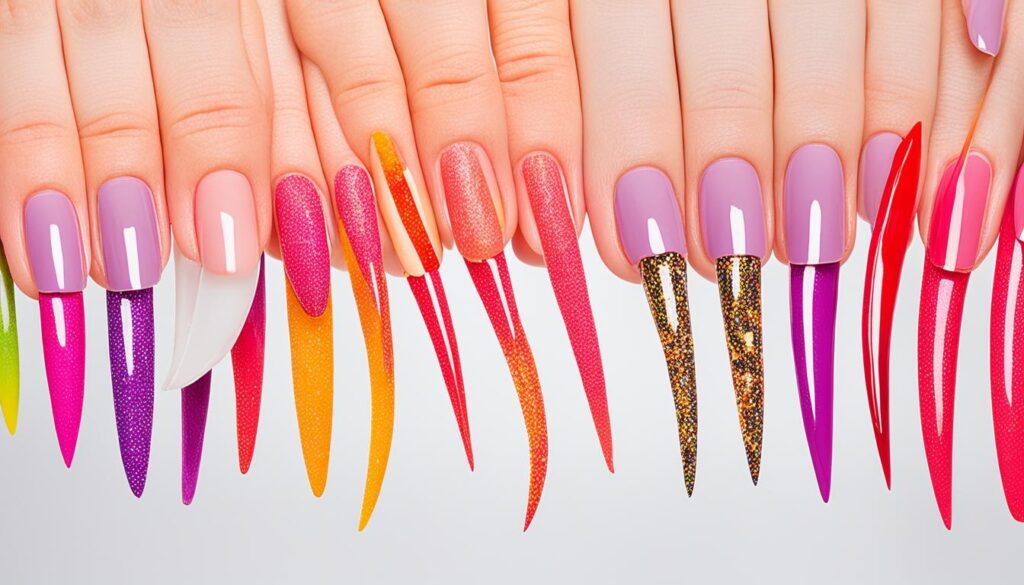
A visual representation of the presentation of in-grown nails, showing the pain, swelling, and infection commonly associated with the condition.
| Presentation | Symptoms |
|---|---|
| Mild | Pain, slight redness, mild swelling |
| Moderate | Increased pain, pronounced swelling, significant redness, tenderness, possible infection |
| Severe | Intense pain, severe swelling, notable redness, infection, deep embedding of the nail, abscesses or ulcers |
Ingrown Toenail Remedies
Dealing with an ingrown toenail can be uncomfortable, but there are remedies you can try at home to alleviate the pain and promote healing. Here are some effective ingrown toenail remedies:
1. Warm, Soapy Water Soak
Start by soaking your affected foot in warm, soapy water for about 15-20 minutes. This will help soften the skin and reduce swelling, making it easier to address the ingrown toenail.
2. Apple Cider Vinegar Soak
Another option is to soak your foot in apple cider vinegar diluted with water. Apple cider vinegar has antimicrobial properties that can help prevent infection and soothe the area.
3. Dental Floss or Cotton Packing
Gently lift the ingrown toenail edge and place dental floss or a small piece of cotton under the nail. This will help separate the nail from the skin and prevent it from digging further into the flesh.
4. Antiseptic Ointments
Apply antiseptic ointments, such as Neosporin, to the affected area to keep it clean and prevent infection. Make sure to follow the instructions on the packaging.
5. Toe Protectors
Consider using toe protectors, like gel toe caps or toe sleeves, to cushion the ingrown toenail and reduce pressure and friction. These can provide additional comfort and protection during the healing process.
Remember, these remedies are intended for mild cases of ingrown toenails. If symptoms worsen or persist, it’s always best to seek medical attention for proper evaluation and treatment.
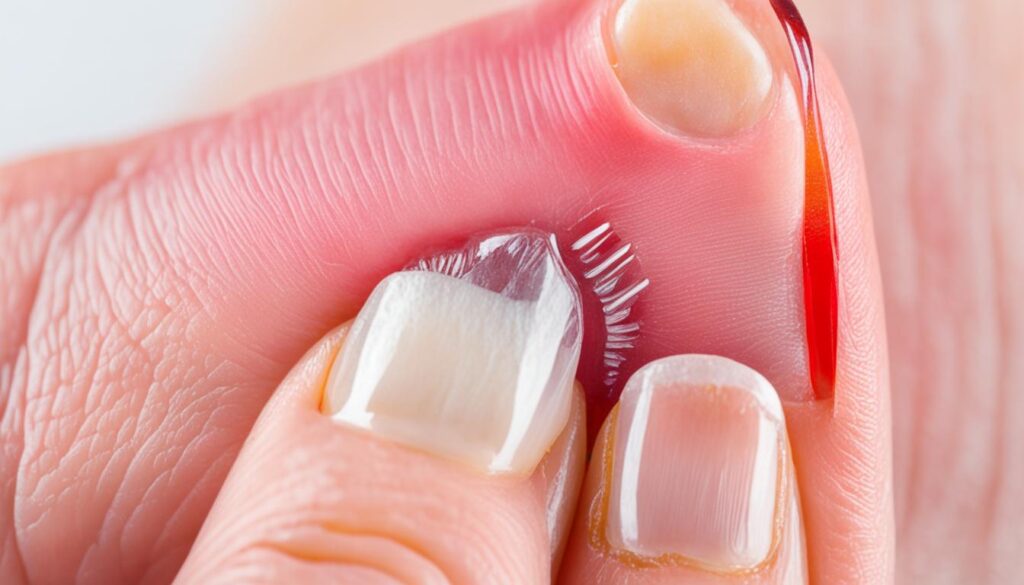
| Ingrown Toenail Remedies |
|---|
| 1. Warm, Soapy Water Soak |
| 2. Apple Cider Vinegar Soak |
| 3. Dental Floss or Cotton Packing |
| 4. Antiseptic Ointments |
| 5. Toe Protectors |
Tips for Prevention and Outlook of In-Grown Nails
Preventing in-grown nails is essential for maintaining healthy and comfortable feet. By following a few simple tips, you can reduce the risk of developing in-grown nails and promote overall nail health.
Proper Nail Trimming
One of the key preventive measures for in-grown nails is practicing proper nail trimming techniques. Trim your nails straight across, avoiding rounded or curved edges. Be careful not to trim them too short, as this can increase the likelihood of the nail growing into the surrounding skin.
Wearing Appropriate Footwear
Choosing the right footwear is crucial in preventing in-grown nails. Opt for shoes that provide enough room for your toes to move freely, without being too tight or constricting. Avoid high heels or shoes with narrow toe boxes, as they can squeeze the toes and contribute to nail abnormalities.
Maintaining Good Foot Hygiene
Keeping your feet clean and dry is important in preventing various foot conditions, including in-grown nails. Wash your feet daily with mild soap and warm water, especially focusing on the areas around the nails. Dry your feet thoroughly, paying attention to the spaces between your toes, as moisture can contribute to nail infections.
Early Treatment for Symptoms
If you notice any signs of an in-grown nail, such as pain, redness, swelling, or infection, it’s crucial to seek early treatment. Ignoring these symptoms or attempting DIY remedies may lead to worsening of the condition or complications. Schedule an appointment with a healthcare provider who can provide appropriate treatment options and guidance.
By following these preventive measures and seeking prompt treatment when needed, you can reduce the likelihood of in-grown nails and maintain healthy and happy feet.
| Prevention Tips | Outlook |
|---|---|
| Proper nail trimming techniques | In-grown nails can be effectively treated and healed with proper care and treatment. |
| Wearing appropriate footwear | Early treatment can prevent complications and promote healing. |
| Maintaining good foot hygiene | Most in-grown nails can be successfully treated and healed. |
| Seeking early treatment for symptoms |
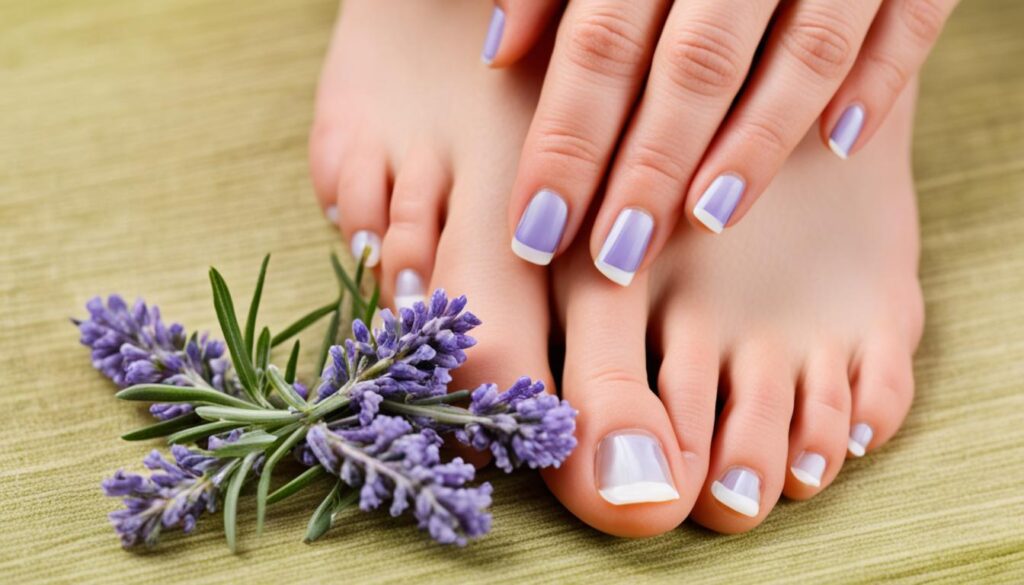
Importance of Timely Treatment for In-Grown Nails
In-grown nails can cause significant discomfort and pain, but timely treatment is crucial to prevent complications and ensure a speedy recovery. Ignoring the problem or delaying treatment can lead to worsening symptoms and possible complications.
Complications of In-Grown Nails
If left untreated, in-grown nails can result in several complications:
- Spreading infection: The skin around the nail can become infected, leading to redness, swelling, and the formation of pus. The infection can spread beyond the nail, causing further discomfort and potential systemic complications.
- Permanent damage: In severe cases, the pressure exerted by the in-grown nail can cause damage to the underlying nail bed and surrounding tissues. This can result in the formation of scar tissue and permanent nail deformities.
To avoid these complications, it is important to seek timely treatment from a healthcare provider as soon as the symptoms of an in-grown nail arise.
“Timely treatment is crucial to prevent complications such as spreading infection and permanent damage to the nail and surrounding tissues.”
Treating in-grown nails promptly can minimize the risk of complications and promote faster healing. Early intervention can help alleviate pain, reduce inflammation, and prevent the infection from spreading.
Seeking Professional Help
If home remedies and self-care measures do not provide relief within a few days or if the symptoms worsen, it’s important to seek medical attention. A healthcare provider can assess the severity of the in-grown nail and recommend appropriate treatment options.
In some cases, the healthcare provider may need to perform a minor procedure to remove the in-grown part of the nail or prescribe antibiotics to treat any underlying infection. They can also provide guidance on proper foot care and preventive measures to avoid future occurrences.
Timely treatment is key to preventing complications and ensuring a quick recovery from in-grown nails. Don’t hesitate to seek professional help if home remedies are ineffective or if the symptoms worsen.
Conclusion
Treating in-grown nails effectively requires a comprehensive approach that combines self-care measures and medical interventions. Thankfully, there are various options available to address this common condition.
For many individuals, home remedies and conservative therapies offer effective solutions. Soaking the foot in warm, soapy water, placing cotton or dental floss under the nail edge, and wearing proper footwear can alleviate symptoms and promote healing. These self-care measures play a crucial role in managing mild to moderate cases of in-grown nails.
However, it is important to note that more severe cases may require medical intervention. Surgical therapies, such as partial nail avulsion and phenolization, or even full nail removal, may be necessary to provide long-lasting relief. Consulting a healthcare provider and seeking timely treatment is essential to prevent complications and ensure optimal outcomes.
In conclusion, by combining self-care measures with medical intervention, individuals can effectively address in-grown nail problems. Whether opting for home remedies or surgical treatments, the key is to take action and seek appropriate care. Remember, treating in-grown nails promptly can alleviate discomfort, promote healing, and help maintain healthy nails in the long run.
